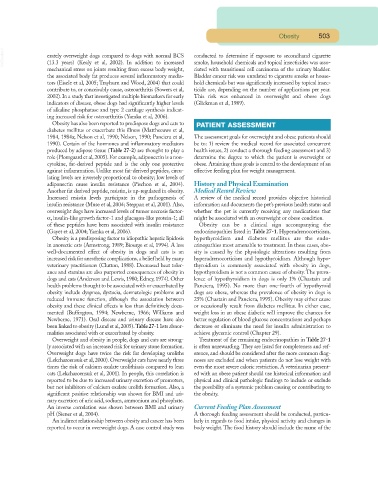Page 487 - Small Animal Clinical Nutrition 5th Edition
P. 487
Obesity 503
VetBooks.ir erately overweight dogs compared to dogs with normal BCS conducted to determine if exposure to secondhand cigarette
smoke, household chemicals and topical insecticides was asso-
(13.3 years) (Kealy et al, 2002). In addition to increased
mechanical stress on joints resulting from excess body weight, ciated with transitional cell carcinoma of the urinary bladder.
the associated body fat produces several inflammatory media- Bladder cancer risk was unrelated to cigarette smoke or house-
tors (Eisele et al, 2005; Trayhurn and Wood, 2004) that could hold chemicals but was significantly increased by topical insec-
contribute to, or conceivably cause, osteoarthritis (Sowers et al, ticide use, depending on the number of applications per year.
2002). In a study that investigated multiple biomarkers for early This risk was enhanced in overweight and obese dogs
indicators of disease, obese dogs had significantly higher levels (Glickman et al, 1989).
of alkaline phosphatase and type 2 cartilage synthesis indicat-
ing increased risk for osteoarthritis (Yamka et al, 2006).
Obesity has also been reported to predispose dogs and cats to PATIENT ASSESSMENT
diabetes mellitus or exacerbate this illness (Mattheeuws et al,
1984, 1984a; Nelson et al, 1990; Nelson, 1990; Panciera et al, The assessment goals for overweight and obese patients should
1990). Certain of the hormones and inflammatory mediators be to: 1) review the medical record for associated concurrent
produced by adipose tissue (Table 27-2) are thought to play a health issues, 2) conduct a thorough feeding assessment and 3)
role (Plomgaard et al, 2005). For example, adiponectin is a non- determine the degree to which the patient is overweight or
cytokine, fat-derived peptide and is the only one protective obese. Attaining these goals is central to the development of an
against inflammation. Unlike most fat-derived peptides, circu- effective feeding plan for weight management.
lating levels are inversely proportional to obesity; low levels of
adiponectin cause insulin resistance (Pischon et al, 2004). History and Physical Examination
Another fat derived peptide, resistin, is up-regulated in obesity. Medical Record Review
Increased resistin levels participate in the pathogenesis of A review of the medical record provides objective historical
insulin resistance (Muse et al, 2004; Steppan et al, 2001). Also, information and documents the pet’s previous health status and
overweight dogs have increased levels of tumor necrosis factor- whether the pet is currently receiving any medications that
α, insulin-like growth factor-1 and glucagon-like protein-1; all might be associated with an overweight or obese condition.
of these peptides have been associated with insulin resistance Obesity can be a clinical sign accompanying the
(Gayet et al, 2004; Yamka et al, 2006). endocrinopathies listed in Table 27-1. Hyperadrenocorticism,
Obesity is a predisposing factor to idiopathic hepatic lipidosis hypothyroidism and diabetes mellitus are the endo-
in anorectic cats (Armstrong, 1989; Biourge et al, 1994). A less crinopathies most amenable to treatment. In these cases, obe-
well-documented effect of obesity in dogs and cats is an sity is caused by the physiologic alterations resulting from
increased risk for anesthetic complications,a belief held by many hyperadrenocorticism and hypothyroidism. Although hypo-
veterinary practitioners (Clutton, 1988). Decreased heat toler- thyroidism is commonly associated with obesity in dogs,
ance and stamina are also purported consequences of obesity in hypothyroidism is not a common cause of obesity. The preva-
dogs and cats (Anderson and Lewis, 1980; Edney, 1974). Other lence of hypothyroidism in dogs is only 1% (Chastain and
health problems thought to be associated with or exacerbated by Panciera, 1995). No more than one-fourth of hypothyroid
obesity include dyspnea, dystocia, dermatologic problems and dogs are obese, whereas the prevalence of obesity in dogs is
reduced immune function, although the association between 25% (Chastain and Panciera, 1995). Obesity may either cause
obesity and these clinical effects is less than definitively docu- or occasionally result from diabetes mellitus. In either case,
mented (Buffington, 1994; Newberne, 1966; Williams and weight loss in an obese diabetic will improve the chances for
Newberne, 1971). Oral disease and urinary disease have also better regulation of blood glucose concentrations and perhaps
been linked to obesity (Lund et al,2005).Table 27-1 lists abnor- decrease or eliminate the need for insulin administration to
malities associated with or exacerbated by obesity. achieve glycemic control (Chapter 29).
Overweight and obesity in people, dogs and cats are strong- Treatment of the remaining endocrinopathies in Table 27-1
ly associated with an increased risk for urinary stone formation. is often unrewarding. They are listed for completeness and ref-
Overweight dogs have twice the risk for developing uroliths erence, and should be considered after the more common diag-
(Lekcharoensuk et al, 2000). Overweight cats have nearly three noses are excluded and when patients do not lose weight with
times the risk of calcium oxalate urolithiasis compared to lean even the most severe caloric restriction. A veterinarian present-
cats (Lekcharoensuk et al, 2001). In people, this correlation is ed with an obese patient should use historical information and
reported to be due to increased urinary excretion of promoters, physical and clinical pathologic findings to include or exclude
but not inhibitors of calcium oxalate urolith formation. Also, a the possibility of a systemic problem causing or contributing to
significant positive relationship was shown for BMI and uri- the obesity.
nary excretion of uric acid, sodium, ammonium and phosphate.
An inverse correlation was shown between BMI and urinary Current Feeding Plan Assessment
pH (Siener et al, 2004). A thorough feeding assessment should be conducted, particu-
An indirect relationship between obesity and cancer has been larly in regards to food intake, physical activity and changes in
reported to occur in overweight dogs. A case control study was body weight. The food history should include the name of the

